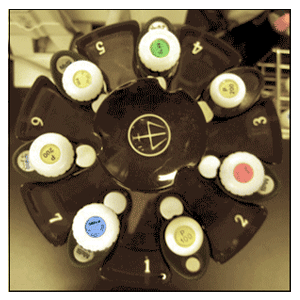Team:KIT-Kyoto/SafetyJ
From 2010.igem.org
(New page: <html><head> <style type=text/css> {text-align: justify;}.tblsample table, .tblsample tr, .tblsample td {border:0px; cellpadding:5; cellspacing:1; ...)
Newer edit →
Revision as of 17:29, 20 October 2010
 
|
Language : English / Japanese |
Questions
There are 4 questions in Safety.
Answers
Q. Would any of your project ideas raise safety issues in terms of researcher safety, public safety, or environmental safety?
A. No issues of researcher safety, public safety or environmental safety raised up during our KIT-Kyoto iGEM 2010 project. All our work was performed fallowing the guidelines of the safety standards required by biosafety level 1. Rules of best microbiological practices were applied. Our project ‘’E.coli Pen’’ enables an appreciator to take a pen, draw and color. Since ‘’E.coli Pen’’ has H2O2 as bacterial killing means, it prevents transgenic E.coli from spreading. (See the article of E.coli survival curve by H2O2 density.)
Q. Do any of the new BioBrick parts (or devices) that you made this year raise any safety issues? If yes, did you document these issues in the Registry? How did you manage to handle the safety issue? How could other teams learn from your experience?
A. No. We developed some parts of producing fluorescence protein used by H2O2 responsive promoter. These parts are completely harmless.
Q. Is there a local biosafety group, committee, or review board at your institution? If yes, what does your local biosafety group think about your project? If no, which specific biosafety rules or guidelines do you have to consider in your country?
A. Yes. We have bio safety group at KIT, and our project has been monitored by them. The leader of this biological safety group was Prof Yamaguchi. Furthermore, there is an upper level committee of transgenic experiences at Kyoto Institute of Technology. Our project has also received accreditation from this committee. All material handled or distributed are non-hazardous and non-infectious. It agrees with all safety standards requested by bio safety level 1. Therefore, Prof. Yamaguchi and other education stuff and Instructors fully support the work done by this iGEM team.
Q. Do you have any other ideas how to deal with safety issues that could be useful for future iGEM competitions? How could parts, devices and systems be made even safer through biosafety engineering?
A. We have 2 ideas. 1. To establish "Best Safety" Prize. This prize awards the team which shows best effort of biosafety-for example, showing or doing new approach of biosafety,and so on. 2. To add a new requirement to earn a Silver Medal; Join local biosafety group, committee, or review board at your institution. If there is not such groupe, make biosafty group and join.
 "
"









